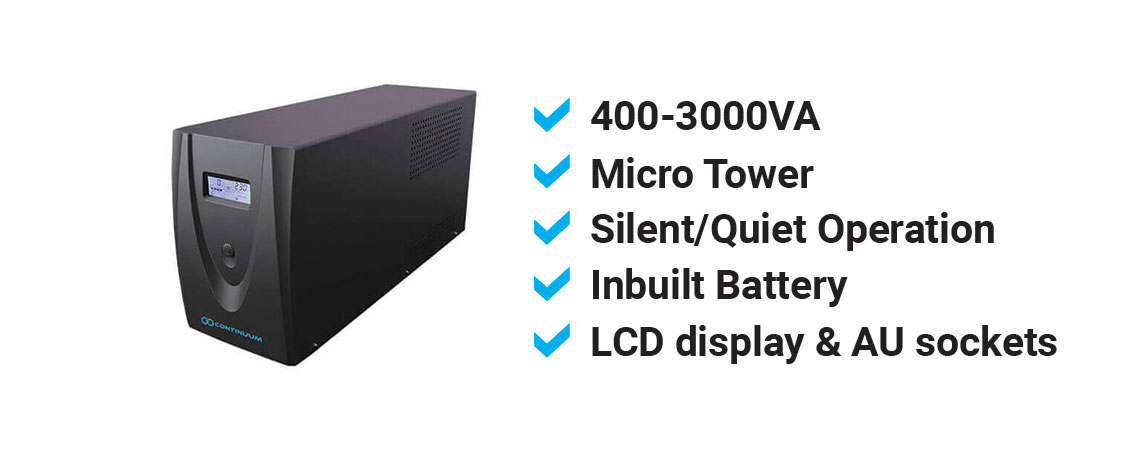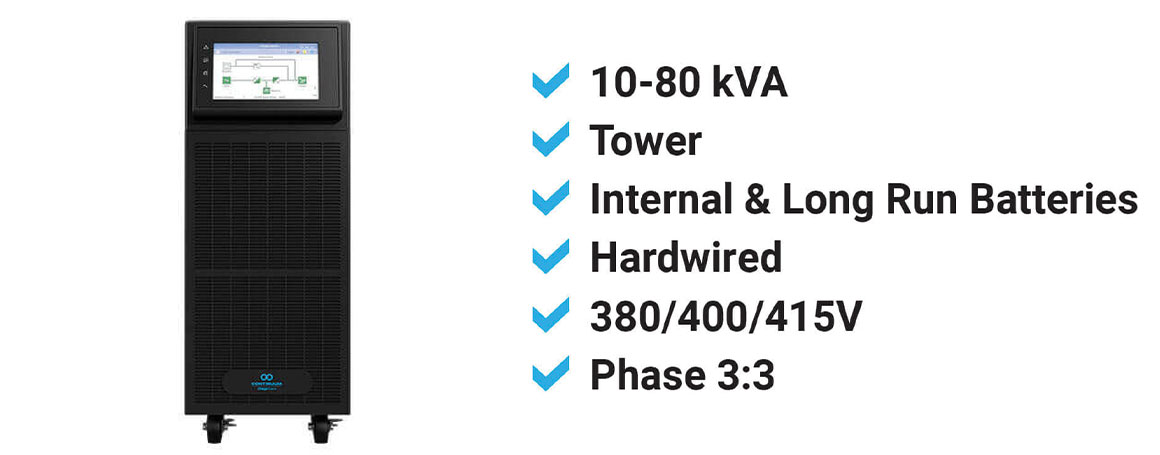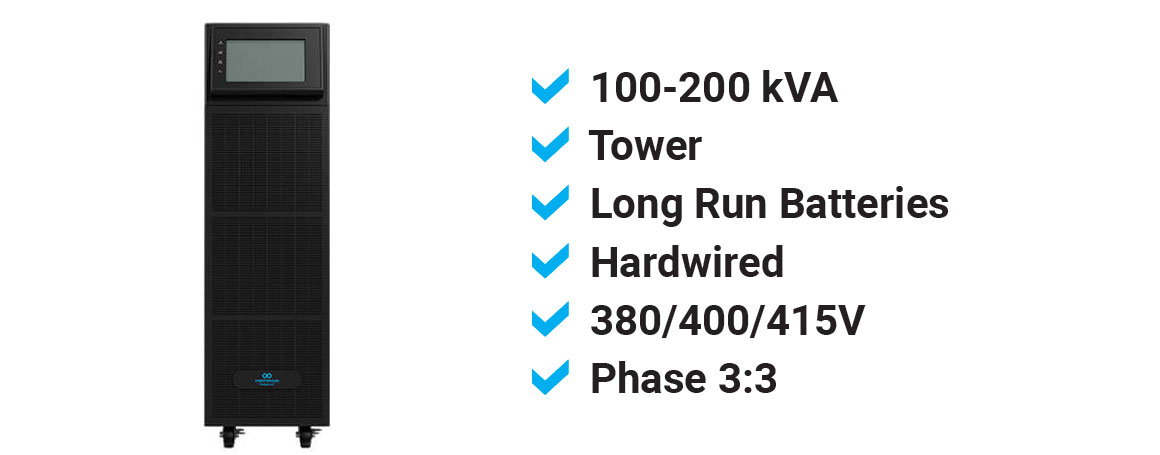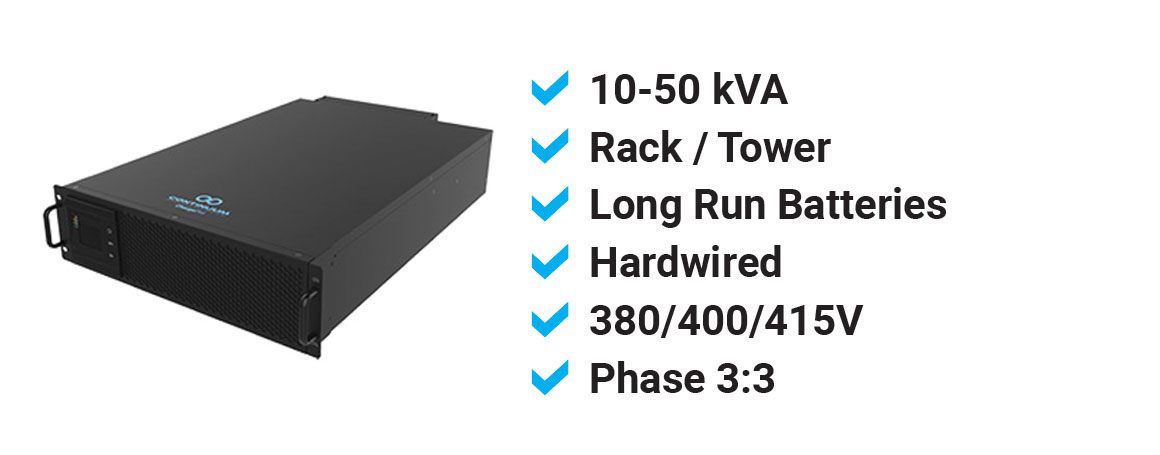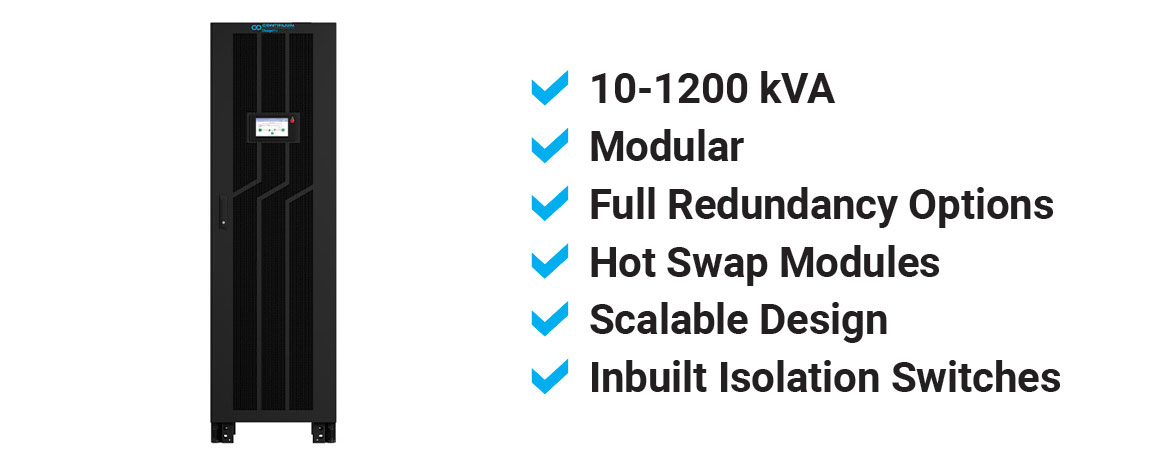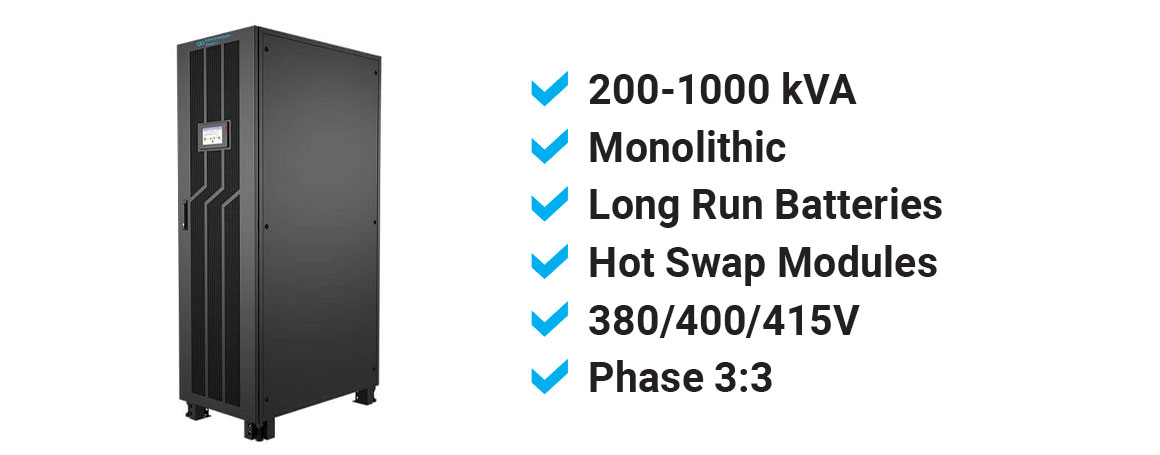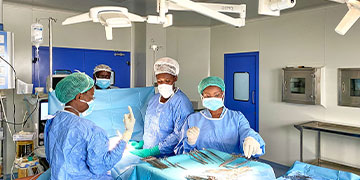We are excited to introduce the latest addition to the Fuseco range – Continuum Uninterruptible Power Supplies!
The Continuum UPS range allows you to protect your electronics, maintain productivity and mitigate the risks associated with power fluctuations and interruptions.
From small-scale home and office setups to large-scale industrial applications, we offer UPS solutions that deliver consistent, high-quality power back up to keep your systems running smoothly.
ChargeShield
ChargeShield is an affordable UPS solution for small office and domestic applications. These come in two forms up to 3kVA. Both Micro Tower and Power Board versions offer ultra quiet operation and auto shutdown for connected computers. In addition, the Power Board type has a USB charge port and universal sockets for AU\US\EU\UK plug types.
ChargeShield Power Board 600-1000VA
Applications:
ChargeShield Power Board range is a compact multi-function unit that can be used among a vast range of applications such as home & home office, and outdoor activities such as camping. The product incorporates a USB charge port and universal sockets ideal for powering overseas equipment. It is ideal for powering small digital loads such as phone chargers, computers, network equipment and lighting.
ChargeShield Micro Tower 400-3000VA
Applications:
ChargeShield Micro Tower range is a multi function unit that can be used among a vast range of applications such as home & home office, education and applications where space is at a premium. This product is also ideal for powering small digital loads such as phone chargers, computers, monitors, network equipment and lighting.
ChargeMaster
ChargeMaster is the ideal choice for the home office, home entertainment system or office space. Protecting single phase loads from power disturbances, blackouts and avoiding costly data loss, ChargeMaster features internal and external battery options. Available in Mini-Tower, Rack-Tower and Tower versions, the ChargeMaster UPS range is an efficient, quiet, yet powerful double conversion UPS.
ChargeMaster Mini Tower 1-3kVA
Applications:
Small Office, Home Office and small factories require UPS that take up a minimal amount of space, have low power consumption, and generate limited noise. The ChargeMaster Mini Tower is the perfect choice for protecting small offices and domestic entertainment systems from damaging disturbances, blackouts and costly data loss.
ChargeMaster Rack / Tower 1-3kVA
Applications:
ChargeMaster rack / tower 1-3 kVA range is a multi function unit that can be used among a vast range of applications such as data centres, security & communication networks, hospitals, education facilities, critical infrastructure and commercial buildings.
ChargeMaster Rack / Tower 6-10kVA
Applications:
ChargeMaster rack / tower range 6-10 kVA is a compact double conversion UPS unit that can be used among a vast range of applications such as data centres, hospitals, education facilities, critical infrastructure and commercial buildings. Supplied standard with SNMP Ethernet and parallel redundancy ports it provides big UPS functionality.
ChargeMaster Tower 10-20kVA
Applications:
ChargeMaster tower range is a 10-20kVA double conversion UPS that can be used among a vast range of applications such as data centres, medical areas, industrial, infrastructure and commercial sites. With a single Phase Output it can operate with single or three phase input providing greater flexibility with site generators. Supplied standard with Generator Walk-In, SNMP Ethernet and parallel redundancy ports.
ChargeGuard
ChargeGuard, the big brother to ChargeMaster, supporting three phase loads and extending up to 200kVA. Ideal for larger offices, industry, data centres and other critical loads this fully featured tower is equipped for larger back up times whilst remaining compact and efficient. Supplied standard with 7-inch colour display, SNMP Ethernet, Generator Power Walk-In and parallel redundancy ports.
ChargeGuard Tower 10-80kVA
Applications:
ChargeGuard 10-80kVA tower UPS range offers the flexibility of internal and external battery solutions, providing a high performance, high efficiency power quality solution that can be used in many applications such as data centres, hospital & medical areas, industrial and commercial, waste-water, desalination plants, rail/transport, banks, telecommunication and education.
ChargeGuard Tower 100-200kVA
Applications:
ChargeGuard 100-200kVA tower UPS range is a high performance, high efficiency power quality solution that can be used among a vast range of applications such as data centres, hospital & medical areas, industrial and commercial, waste-water, desalination plants, rail/transport, banks, telecommunication and education.
ChargePro
ChargePro range offers the highest site protection. Fully Scalable from 10kVA to 1200kVA, this UPS is ideally suited to ultra-critical power supplies such as Hospitals, Airports, Mining, Data Centres and anywhere power interruptions are forbidden. Supplied standard with 7-inch colour display, SNMP Ethernet, Generator Power Walk-In and parallel redundancy ports. Best in class efficiency up to 97.1%.
ChargePro Rack / Tower 10-50kVA
Applications:
ChargePro rack / tower range is a double conversion high performance UPS for customer racks or in tower configuration. It can be used among a vast range of applications such as data centres, hospital & medical areas, industrial & commercial, waste-water/desalination plants, rail/transport, banks, telecommunication and education.
ChargePro Modular 10-1200kVA
Applications:
ChargePro modular UPS range is a fully customisable power quality solution. Available as standard with hot swap redundant modules, and available with inbuilt isolation and mechanical bypass options it is ideal for the most demanding and critical applications such as medical, defence, mining, transport, data centres and education facilities.
ChargePro Monolithic 200-1000kVA
Applications:
ChargePro monolithic range is a fully featured high power modular UPS featuring hot swappable power modules but supplied in a factory preconfigured format. Ideal for the most demanding and larger critical applications such as defence, medical, mining, transport, data centres and education facilities.
Why Fuseco?
With a team of experienced professionals available to assist with any questions or concerns, Fuseco is dedicated to ensuring customers are completely satisfied with their purchases.
We're here to help
Talk to an expert today.
Our friendly team of highly trained specialists will quickly assist you.
We promise to respond within 4 business hours (AEST).
Or you will receive $100 off your next purchase. Read how it works.

Highest Efficiency
Continuum utilise a high frequency transformer-less design, giving the highest efficiency possible. This reduces internal heat and secondary cooling requirements.

Pure Sinewave Output
The Online Double Conversion UPS provides a clean pure sinewave with accurate voltage and frequency regulation. Ideal for sensitive loads.

Immunity from Supply Disturbances
The Continuum Double Conversion UPS isolates the protected load from poor input power.

Improved Power Factor
A Continuum UPS increases Power Factor as high as 0.99, dramatically lowering input power requirements.
Top FAQs
Yes, a Continuum UPS will extend the service life of critical components whilst retaining work or process efficiency.
Yes , many models have modular batteries or modular power modules allowing your UPS to grow with you and your business.
When compared to older UPS types, a Continuum UPS is among the highest efficiency UPS products incorporating power saving features and best of class circuit design.
There are several factors that influence sizing a UPS system, including the combined load of all the equipment the UPS will protect, scope for further system expansion, battery runtime and redundancy.
As well as choosing the right UPS topology, correctly sizing an uninterruptible power supply is crucial. Under-sizing inevitably causes immediate problems, while initial oversizing will waste energy, money and valuable floor space.
The easiest way to ensure a correctly sized UPS system is to get prospective suppliers to undertake a full site survey where they can accurately assess your requirements. However, it is possible to broadly size a UPS yourself by following a step-by-step process.
Critical or Non-Critical Loads
This starts with listing and reviewing all the equipment that will need to be protected by the UPS. Establish whether an item of equipment is critical – and therefore will need the emergency backup provided by the UPS – or non-critical, which can be allowed to fail when the mains power supply does so.
Power Range
The next step is to calculate the total power range for the combined critical load that needs protecting. It’s important to base this on use during peak working hours, rather than on quieter times such as an office network during the night. Equipment labels and supporting technical data will provide information such as the supply voltage, frequency, number of phases, load current, power factor and power consumption. The power consumption of electrical equipment is stated in either Watts (W) or Volt-Amperes (VA). Because UPS systems are rated by VA or kVA ratings, this may require a conversion from W to VA, which can be calculated by dividing the power consumption (W) by the power factor. Add up all the VA, then multiply this by a figure such as 1.2 or 1.25, which factors in future growth and system expansion. That figure is the maximum size in VA or kVA that your UPS should be. Note that a UPS should never be sized to run at 100% load capacity, as this isn’t recommended for safe, stable and reliable performance.
Potentially Problematic Loads
Certain equipment (i.e. laser printers, blade servers, air conditioners, certain lighting systems, motors and compressors) have an in-rush of current during start-up or draw higher currents in normal operation, which can cause the UPS to overload. This can lead to intermittent alarms or potentially send the UPS into bypass mode. For these types of load, good practice suggests two options: either remove them from the power protection system (if the equipment can safely power down on mains failure) or oversize the UPS by a factor of at least three.
Battery Runtime
This is the amount of time you want the UPS to keep equipment operating in the event of a power failure. How to size a UPS battery depends on the nature of the equipment. In some circumstances, runtime only needs to be for a few minutes as a bridge to let the standby generators kick-in and take over.
The battery duration at a specified load level is referred to as the battery ‘autonomy’. A UPS battery can be sized to support loads from a few minutes up to several hours, however the cost of a large battery at a high load level can sometimes mean that a diesel generator should be considered. Increasing the ‘autonomy’ is achieved by adding extra battery strings connected in parallel, however it is important that the charging capability of the UPS system is considered.
Uninterruptible power supplies operating in parallel refers to when the outputs of two or more UPS are connected to supply the load via a common AC busbar.
There are two main configurations:
- Parallel-Capacity (N) where the total load demand is met by a number of UPS without the provision of any redundancy.
- Parallel-Redundant (N+X) where the total load demand is met by all the UPS sharing the load between themselves equally. If one of the UPS fails, the remainder are able to continue supporting the load.
‘N’ configuration solutions do not increase system resilience because they lack redundancy - they simply enable increased overall capacity by connecting multiple UPS to work together. The total capacity is calculated by the number of UPS modules used (also known as a Total Power System).
Because of the lack of redundancy, carrying out maintenance on a parallel-capacity installation means bypassing the entire UPS system so that one or more modules can be powered down for service. During UPS maintenance, the load is powered directly by the mains supply, so it is unprotected to any interruptions.
‘N+X’ configuration solutions are commonly used to protect mission-critical applications in data centres, industrial sites and larger business operations. The main principle behind a parallel-redundant UPS system is that it can continue to support the critical load should one or more UPS modules fail. Compared to N capacity installations, this means it can achieve higher availability and MTBF (mean time between failure).
In addition, this also enables UPS maintenance to take place without interrupting the load. Modules can be powered down for servicing while the remaining UPS continue supporting the load.
During normal operation, each UPS shares the load equally. Similarly, when the UPS system needs to run on batteries, each UPS will still share the load as each module has its own battery set, rather than a shared common battery.
If any of the UPS modules in a parallel-redundant configuration fails or experiences an internal fault, it automatically disconnects from the output AC busbar, while the remaining active UPS continue sharing the load.
In addition to parallel-capacity and parallel-redundant, there are other configurations to consider:
Isolated-Redundant: this is sometimes known as N+1 but it differs considerably to a parallel-redundant N+1 installation. In this configuration, there’s a main UPS module that feeds the load, while the secondary UPS feeds its static bypass. When a fault causes the primary UPS to transfer to bypass, the secondary module accepts the full load.
Distributed-Redundant: also known as Tri-Redundant and typically used in large multi-megawatt data centres. Made up of three or more UPS with independent input and output feeders, with the output buses connected to the load by several PDUs (and in certain cases Static Transfer Switches). This configuration does minimise single points of failure and offers the opportunity for concurrent maintenance, but it also leads to significant load management challenges.
Power factor (pf) is the difference between actual energy consumed (Watts) and the apparent power (Volts multiplied by Amps) in an AC circuit. It is calculated as a decimal or percentage between 0-1 pf and 0-100% i.e. 0.9 pF = 90%. The nearer the power factor is to unity (1 pf), the closer the two waveforms are in phase with each other and the device uses power more efficiently, hence why power factor relates to UPS efficiency.
Convention stipulates that inductive loads are defined as positive reactive power, with capacitive loads defined as negative reactive power. But power factor is never described as positive or negative, it is either lagging or leading.
Lagging Power Factor
These are loads where the current waveform lags behind the voltage by a factor equal to the load’s reactance, typically between 0.5 and 0.95.
Unity Power Factor
Unity power factor (1 pf) loads have the current and voltage waveforms in phase with each other. In the example below, a 2300 VA load with 1 pf has a real power value of 2300 W (2.3 kW).
Leading Power Factor
Loads with a leading power factor have a current waveform that leads the voltage by a factor equal to the load’s reactance, usually between 0.8 and 0.95. Using the same 2300 VA as in previous examples, a leading power factor of 0.766 has a real power value of 1762 W (1.76 kW).
Traditionally, UPS systems were designed to support loads with unity or lagging power factors.
However, modern uninterruptible power supplies can also now handle leading power factors. It does require careful planning during installation though, as leading power factors can place an overload on the UPS that it may not recognise.
Blade servers are the best example of a load with a leading power factor. They are capable of greater processing power within less rack space than traditional file servers and have been widely adopted in the telecoms and data centre sectors because of advantages such as simplified cabling and reduced power consumption.
There are several ways to try and reduce the impact of leading power factors, including increasing the size of the UPS, but the most common approach is to use active harmonic filters with power factor correction on the output.
This delivers a more acceptable load to the UPS, but it does reduce efficiency, take up more floor space and increase capital costs.
Applicable Industries
My client purchased four robots to milk cows 24/7. At the start of the project, I asked the OEM - “How quickly will the robots reboot/reset after an outage? You should know that we get outages all the time and that we get voltage swings with all the PV”. OEM - No answer. It was then decided to install two 10kVA UPS systems to fill the gap between an outage and the backup diesel generator supporting the customer’s load. Fuseco, a specialist in this area, were a great help in producing a solution for the split phase 480VAC system.
Peter Bulle
Director at CoGen Plus

Dealing with your team has been a very positive experience. The Continuum UPS solutions in conjunction with your professional advice solved our Demand Load Management challenges perfectly.
Frank Leonis
Project Engineer at SMEC

Reliable continuity of supply has been an issue for this project from its inception. The Continuum solutions implemented here have solved this issue and have given us peace of mind. Thank you guys for your patience, expertise and support.
Lawrence Cheng
Engineering Manager at ARUP
Technical Support
Our experts are all pre-eminent leaders in electrical products who provide excellent support in their areas of expertise.
Technical supportTalk to an expert
Our friendly team are highly trained product experts who really enjoy helping customers find what they need.
call 1300 387 326Enquire by email
We promise to respond within 4 business hours (AEST) or you will receive $100 off your next purchase.
Enquire now
